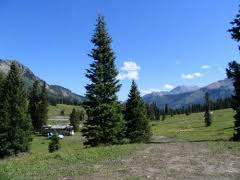In last weekend’s post, How boondockers deal with waste water, we examined the control of waste water and their tanks that always fill too quickly–especially when exercising wasteful habits. This week I will show how to go about camping out in the boonies on what is called public land–the heart (and art) of boondocking.
So just where can you camp legally outside of designated campgrounds? The answer to that question used to be “anywhere.” But that is changing as you will see below.
 There are millions of acres of public lands which are open to all forms of recreation, including camping and boondocking. Wikipedia defines and identifies public lands this way: “The majority of public lands in the United States are held in trust for the American people by the federal government and managed by the Bureau of Land Management (BLM), the United States National Park Service, Bureau of Reclamation, or the Fish and Wildlife Service under the Department of the Interior, or the United States Forest Service (FS) (photo-left) under the Department of Agriculture. Other federal agencies that manage public lands include the National Oceanic and Atmospheric Administration and the United States Department of Defense, which includes the U.S. Army Corps of Engineers.”
There are millions of acres of public lands which are open to all forms of recreation, including camping and boondocking. Wikipedia defines and identifies public lands this way: “The majority of public lands in the United States are held in trust for the American people by the federal government and managed by the Bureau of Land Management (BLM), the United States National Park Service, Bureau of Reclamation, or the Fish and Wildlife Service under the Department of the Interior, or the United States Forest Service (FS) (photo-left) under the Department of Agriculture. Other federal agencies that manage public lands include the National Oceanic and Atmospheric Administration and the United States Department of Defense, which includes the U.S. Army Corps of Engineers.”
Most of these public lands are open for recreational use, though the type of recreation depends on the managing agency. On Forest Service and BLM lands restrictions are minimal (BLM alone manages 253 million acres–one-eighth of the country’s landmass, but most of it is in the eleven western states). Public lands, however, are more controlled in national and state parks where camping outside of designated campgrounds is usually not permitted.
 Wildlife refuges and state wildlife management areas (photo-left) are managed to improve wildlife habitat, but often allow primitive (no hookups) camping, except when closed to protect wildlife mating and nesting, or to reduce stress on animals.
Wildlife refuges and state wildlife management areas (photo-left) are managed to improve wildlife habitat, but often allow primitive (no hookups) camping, except when closed to protect wildlife mating and nesting, or to reduce stress on animals.
Public land is also leased for cattle grazing, but this doesn’t prohibit you from camping (gated private land will have signs designating it as private and will have No Trespassing signs posted. If you see a gate without a lock, you are permitted to open and go through the gate, though be sure to close it after you enter. These gates are not meant to keep you out, but rather to keep cattle from wandering off the land and into the roads. These cattle leases are large and you may not even see any cattle while you are camped.
Next week: Part Two will look at more public land camping.
For more RVing articles and tips take a look at my Healthy RV Lifestyle website, where you will also find my ebooks: BOONDOCKING: Finding the Perfect Campsite on America’s Public Lands (PDF or Kindle), 111 Ways to Get the Biggest Bang for your RV Lifestyle Buck (PDF or Kindle), and Snowbird Guide to Boondocking in the Southwestern Deserts (PDF or Kindle), and my newest, The RV Lifestyle: Reflections of Life on the Road (Kindle reader version). NOTE: Use the Kindle version to read on iPad and iPhone or any device that has the free Kindle reader app.